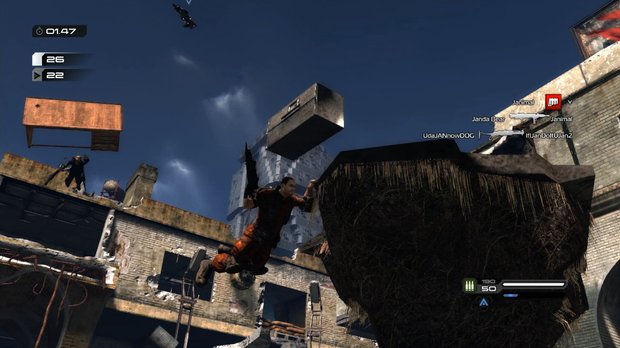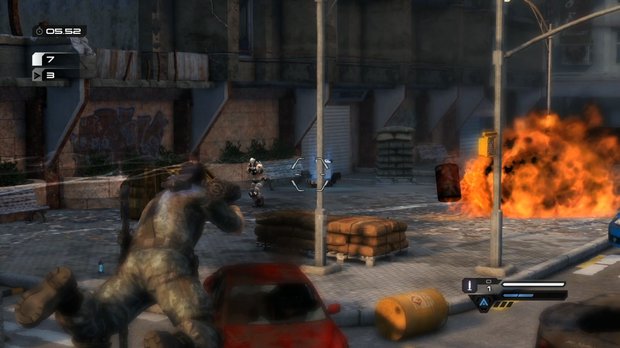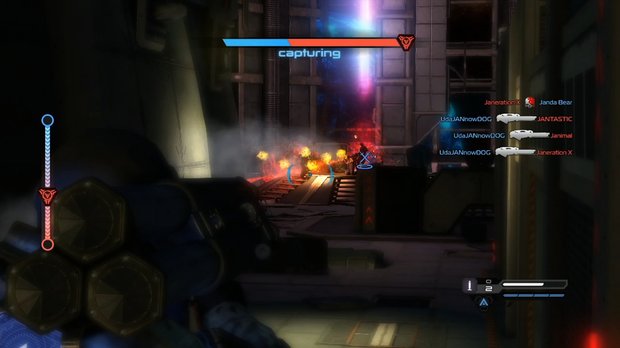Inversion hands-on multiplayer preview
Gravity is the weapon of choice for humiliating opponents
We’re floating a few feet above the ground, but we didn’t choose to be here. A second ago, as we were drawing a bead on our opponent, about to blow him to pieces with our shotgun, he fired off a ball of blue energy, which destabilized gravity in a small radius under our feet. So we end up floating, helpless, as he prepares to splatter our cranium with his sniper rifle. Lucky for us, we saved up some energy and can use it to perform a short juke to the side in mid-air, and once oriented, can return fire. We barely manage to send him shattered and limp to the floor, when a moment later another opponent rounds the corner.

Unlucky for him, the earlier victim’s low-G field has worn off, so we land on our feet, swap our own power from low-G to high-G, turning the glowing color on our suit to red. This new opponent uses his low-G power the snatch a floating chunk of debris from a nearby area of natural zero-G. He turns to launch this block of concrete at us, so we activate our high-G secondary power, an energy shield, just in time to make the projectile break apart harmlessly. Our power is depleted, so we do an evasive roll toward an energy canister and grab it while our enemy’s assault rifle rounds launch plumes of dust in the floor behind our movement. Back on our feet, we fire a red blob of energy, and as it bursts, the poor fool who thought he’d get an easy kill suddenly succumbs to immense gravity and stumbles down to all-fours, unable to defend himself. We decide to go for the extra insult of a melee kill, stomping his head to gristle and bone.
This is not how Inversion’s multiplayer will likely play out for you when you first jump into it. Juggling the different powers available feels like… juggling. It doesn’t come naturally, but it also doesn’t take too long to learn. At first we played it like other third-person shooters and focused on the conventional weaponry, but the first time we got hit by a gravity power we remembered, “Duh, we should be using those too.” Of course, if you end up playing the single-player (or co-op) campaign first, you’ll already have the gravity powers down pat, which will be useful for multiplayer.

In the aforementioned scenario we were playing Deathmatch on a map with a large courtyard surrounded by bombed-out buildings. In the central open area, there’s no gravity, with a few floating platforms strewn about. Entering the zero-G just requires you find a take-off point indicated by a big green circle on the ground, and then you launch yourself in a straight line, so you want to line up with a platform so you have something to grab onto (think the first Dead Space in terms of flying from point to point in zero-G). It’s dangerous because you’re a sitting duck out there, but if you can make it up to the roof, all the powerful weapons are there.
Another mode we played is called Hourglass, where two teams compete to capture and hold a single defense point – and when the point is captured the entire level flips over and everyone fights on the ceiling (like an hourglass flipping over). Finally, we saw Survival mode, which is actually a co-op four-player mode where you and your teammates fight waves of enemies, but instead of simply defending a “hill” you move through checkpoints, working from one arena to another until it culminates in a boss battle – in the one we played, we fought through the streets of a city and then went up against a mech boss in a parking garage.
We’re not sure how we feel about the multiplayer yet. It has promise with the gravity powers and the ways that levels can be twisted around with gravity anomalies, but we did encounter some things that could become hurdles for the fun. For one, the aiming sensitivity is strangely really low – we went into the options and tried to crank it up but discovered it was already at the maximum, and we’re talking about aiming so sluggish that an enemy running laterally to your position can actually outrun your turn rate, making aiming a bit frustrating. That is an easy thing to remedy before release, so let’s hope it does get fixed because otherwise hardcore shooter players will quickly dismiss the multiplayer.

We’re also not sure how we feel about the gravity powers as they apply to multiplayer. In single-player it’s fun to launch foes into the air and play skeet-shooting with them, but in multiplayer it’s kind of annoying for an enemy to shoot you with a splash weapon that makes you helpless for a second. We’re a bit worried the multiplayer may devolve into “see enemy, whoever gets off the no-aiming-required gravity shot first wins.” But we can’t be sure of that with just a couple hours of play – after all, we did find that a simple dodge-roll can avoid gravity shots, so it may be easy to bait an opponent into using his gravity power too soon, making the game more about tactics and faking opponents out instead of who has faster reaction times.
Sign up to the GamesRadar+ Newsletter
Weekly digests, tales from the communities you love, and more
With Inversion’s multiplayer we’re left with the same feeling we’ve had playing the single-player: there’s a cool core idea here with tons of potential since the possibilities for gameplay revolving around both gravity weapons and gravity anomalies in the environment are endless, but we don’t know if the game is going to properly capitalize on that potential. We’ve seen inklings of it here and there, but will it go all-out and really show us some crazy, creative twists on gravity? We haven’t seen a ton of the game, and we have the feeling that the stuff that has been shown has been the “gentler” examples of warped gravity because the devs don’t want to shove on us a bunch of advanced, disorienting stuff that’s meant to be encountered after you’ve been eased into the game’s mechanics. As of now we’re still waiting for the game to show us it has the imagination to follow through on its premise, and we really want it to pull it off because it could be much more than just another shooter.
Sep 12, 2011



